
April 18, 2023
Best Product Development Methodologies
When team members are 95 percent committed to an agile methodology, their productivity doubles compared to those with 50 percent, says research by CA Technologies spanning 160,000 projects and 50,000 agile teams. Although the improvements were not as pronounced as those in productivity, quality, predictability, and responsiveness were also better with more dedication.
It is only one example of how beneficial a product development methodology can be for a business. Although frequently associated with software development methodologies, they also work in a broader context. The development team's product development methodology involves the entire product planning process and all functions.
This article explains why product development methodologies matter, lists the most common ones, compares agile and waterfall methodologies, and provides necessary forms of program development techniques. We will also introduce you to Artkai, an award-winning full-cycle product development company, and our expertise in product development methods based on the following case studies: Procredit, Coinloan, Cruitment, Huobi, Nezha, and DTEK.
Why Methodology Matters?
Creating products is a collaborative effort comprising numerous functional groups. Cross-functional teams must interact methodically to generate value quickly and effectively by offering precise instructions for accomplishing work. Using a shared product development methodology aids in driving success.
Typically, an organization determines which method its team will employ. Every organization that creates and delivers goods, including engineering, IT, and product and project management, should adopt it. The methodology your business picks impact how you make the product development roadmap. Below we will describe some of the most popular methodologies and how they relate to product management.
Common Product Development Methodologies
The methodologies listed below have a strong foundation in software development because businesses that produce technological products frequently employ product managers. They might work on a sold external product or a business-supporting internal product. Yet companies that produce actual goods also use many of these methodologies.
Agile methodology
Agile is a group of software development methodologies that encourages delivering products incrementally and iteratively. Agile evolved to assist development teams in responding more quickly to customer requirements. Many businesses integrate agile concepts across the organization to enhance cooperation, adapt to change, and deliver working results more quickly.
Instead of being linear in progress ( one stage is finished and only considered again once the product is ready), agile product development emphasizes continuous and iterative product development. That is, each sprint cycle represents a complete iteration and is repeated again.
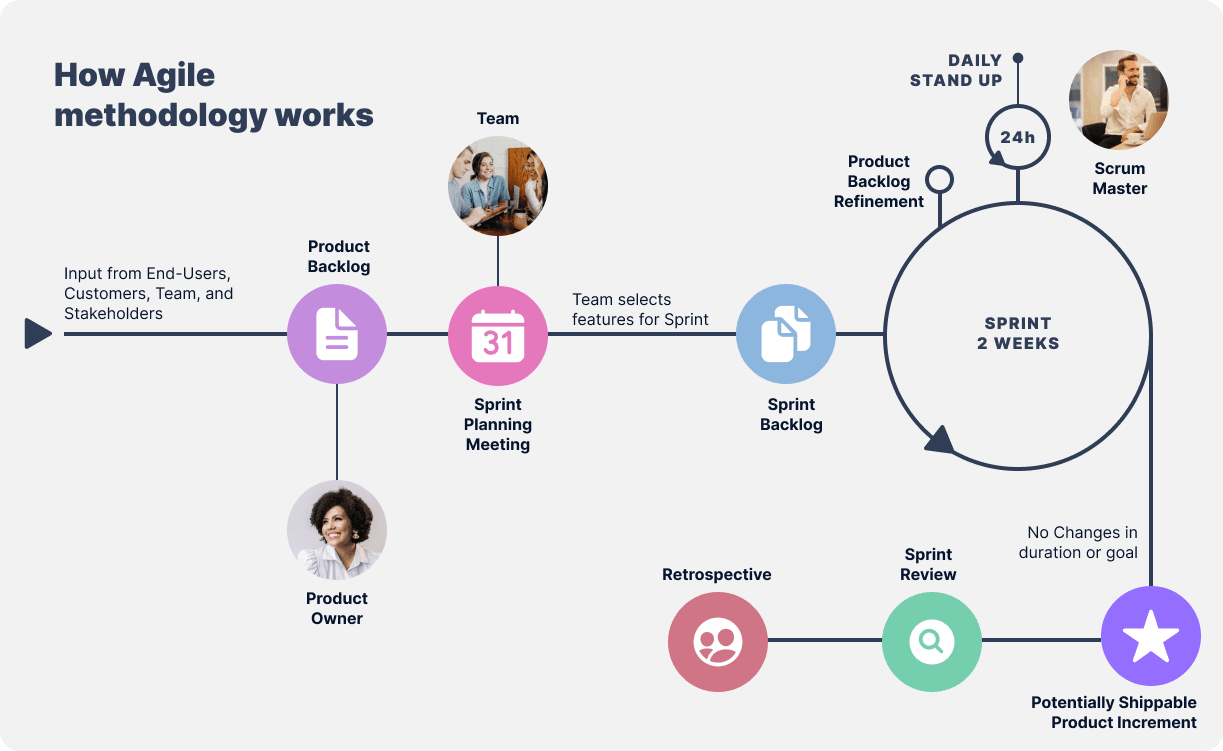
At Artkai, we adhere to the Agile method of organizing the mobile app development process to guarantee that the client is constantly on track and receives timely progress reports from the team. At the same time, the time for expensive revisions and errors is minimal.
Kanban Process
Kanban emphasizes continual value delivery in workflow management. It is a lean methodology that focuses on visualizing work to improve collaboration, limiting the amount of work in progress, and continuously optimizing flow to shorten lead times.
The Kanban process justifies steadily reducing the work in progress by determining the maximum level of5 stress the pipeline can withstand while operating efficiently and avoiding bottlenecks. The Kanban process is frequently combined with agile techniques for greater productivity.
The Artkai development team has robust experience with the Kanban delivery process. For instance, we have used a Kanban board in the development process of Cruitment, a SaaS platform for the HR/recruitment teams in small & medium companies, to provide an overview of the recruitment progress in one single-board view.
Scrum Process
Scrum is an agile method that emphasizes completing work in time-limited work periods, known as sprints. The team decides on the scope of work, chooses items from the product backlog, and establishes a sprint target before beginning each sprint. The team presents the finished product to business stakeholders for review at the end of the sprint.
In the scrum methodology, the team identifies new updates and prioritizes them jointly, manages backlogs, and shares feedback on the learned lessons, achievements, and gaps. This method enables teams to regularly produce working software while allowing for change integration throughout the project's lifetime.
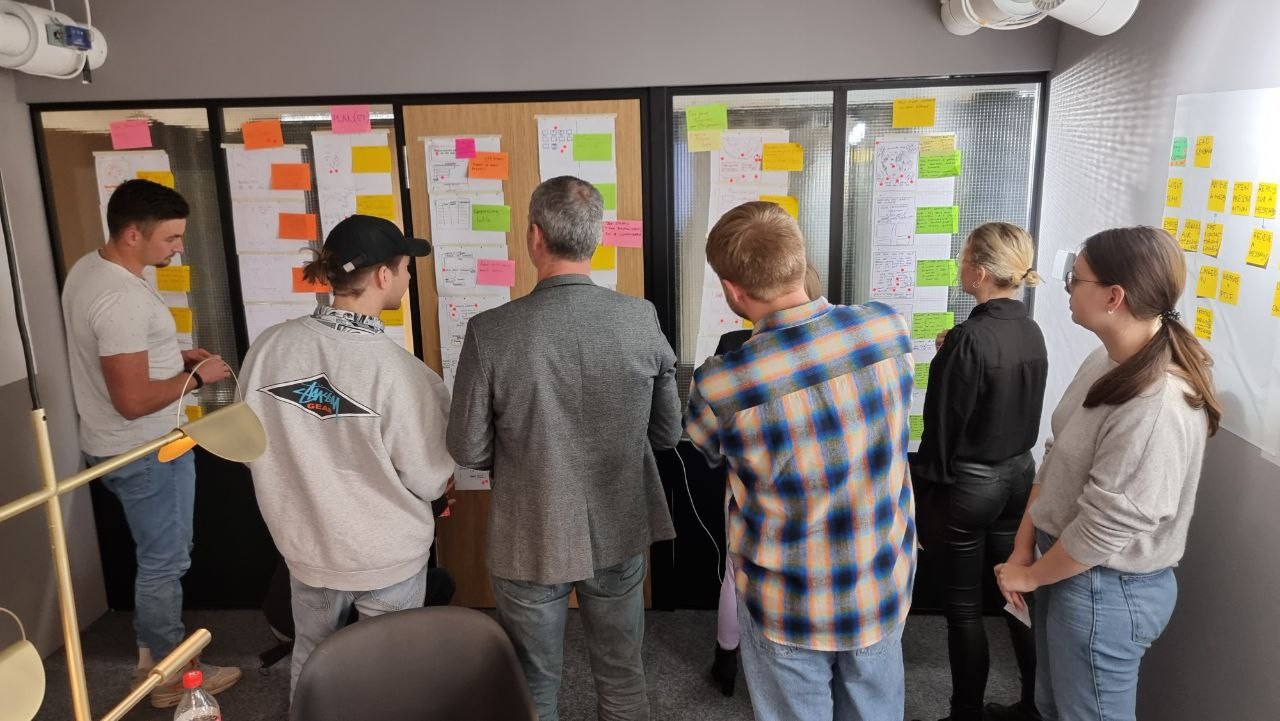
Artkai implements Scrum to conduct scrum follow-up meetings when essential project milestones are reached. These meetings promote effective problem-solving and facilitate productive collaboration between teams. Web and mobile app production for Procredit Georgia is an example of how we use Scrum sprints in product development.
Waterfall Methodology
In the Waterfall method, projects are delivered in phases using a sequential approach. This methodology works effectively for projects where requirements can be precisely defined upfront, and modification is rare. Waterfall has its roots in sectors like manufacturing and construction, where goods are developed linearly. Delivering a set scope of work by the project's completion is paramount.
In contrast to Agile, which emphasizes sprint-based documentation, waterfall foresees intense documentation for each stage of the work. Fewer businesses use waterfall than fifteen years ago because of the rise of customer-centric product development, which relies on shifting consumer preferences and opinions to drive product improvements. Let’s grasp the comparison of the Agile and Waterfall methods in detail.
Agile and Waterfall Methods: Similarities and Differences
While Agile-based product development methodologies and the waterfall development method share certain similarities, Kanban and Scrum's differences are becoming more obvious. Let's examine the primary distinctions between these two strategies and their remaining parallels.

Revenue Generation and Development Time
The final version of a product, when it requires very few updates and is already well-established, requires roughly the same number of development hours for both Agile and Waterfall approaches. However, the launch time for Agile is substantially shorter. What may take weeks or months in Agile, typically require years in Waterfall.
- Agile development leads to substantially quicker product launches and the beginning of revenue generation. Even in the early iterations, where the product is usable and might even be entirely free to use, it collects much customer feedback both during the beta period and after the product has been released. The product's utility grows exponentially, and the Agile method allows it to be responsive to any modifications in user behavior and preferences.
- The rigorous nature of Waterfall development leaves very little flexibility for gathering and incorporating feature-based feedback while a feature is still being developed. It means the product does not generate revenue or expand its user base over development. Therefore, it may miss out on emerging trends and competitively introduced new features.
Role of User Surveys and Customer Feedback
Both Waterfall and Agile methodologies include feasibility studies that call for customer input. A development project can proceed only by passing customer feedback evaluations that ensure the intended product will have a particular level of adoption-based utility. Conjoint analysis is a vital component of both approaches used for market viability tests now.
- Agile approaches consider the limitations of feasibility surveys and research and put a lot of effort into gathering user test input before launch and consumer feedback after launch. It makes Agile product teams more responsive to shifting user preferences and helps them outperform established market competitors.
- Waterfall prioritizes user interface testing and product usage input before beginning development work. It does not carry out end-user research for each produced feature. For this reason, the final product may lack crucial functionality based on new user behaviors since development time is significantly longer for the Waterfall method.
Developmental Iterations and Stages
The stages of Waterfall still apply to each iteration of an Agile project, even if it is intended to work in multiple iterations. These include ideation, planning, development, testing, and release.
Agile iteration planning is much more feedback-centric, while in Waterfall, each iteration is contained by the set work-in-progress limits. The entire developmental deck is planned at once. Moreover, user testing in Waterfall is focused mainly on UI/UX rather than feature utility.
Human Resource and Investment Requirements
Lead teams can use Agile methodologies to produce a product ready for launch, and they can dynamically scale based on requirements and successes with each iteration. Because of this, an Agile team can start small and expand as the product succeeds.
Waterfall demands a more significant initial capital outlay since it engages teams based on the overall strength required to produce the finished product at a time when ROI and revenue possibilities are simply projections.
Important Forms of Product Development Techniques
Regardless of your business's size, goals, values, or market share, managing the workflow can be tricky. How can we deal with change, adjust, and take advantage of it? What happens when the workflow we believed we had under complete control changes unexpectedly? Here are the top 4 product development techniques to have you covered.
Lean Hypothesis
Lean Hypothesis divides the process into testable segments. It minimizes risk, speeds up development, and fosters product trust. It is a highly alluring and helpful product development technique. Lean hypothesis works best when you need to fix a problem that you found with a particular step in the process. It is also beneficial when you have a product idea and need to be concise and organized.
With this technique, you can individually intervene in each stage of the product's development as soon as a problem is found and rebalance it. As a result, you will have a smoother experience for the customer and flawless operation of the product.
The Full Marketing Funnel
Due to the complexity of the marketing process, it should be handled in segments, giving each stage the consideration and research it requires. Because of this, the Full Marketing Funnel technique is quite effective. It emphasizes conversion between stages rather than just the final conversion.
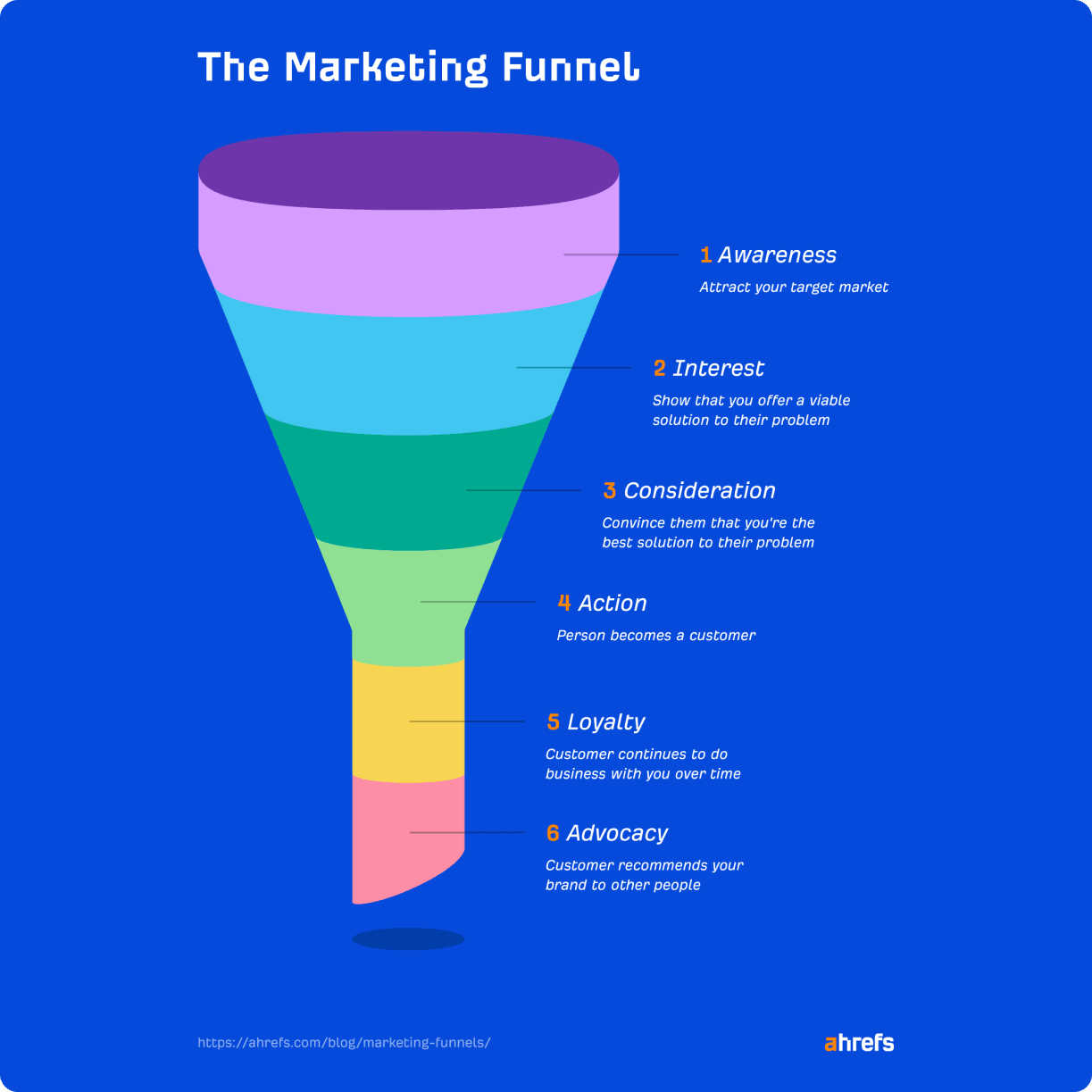
Essentially, it focuses on the 360-degree customer journey, always cultivating relationships and creating better brand experiences along the way rather than just at the end, from the awareness stage through consideration and conversion. Businesses should invest in this technique to succeed in a highly competitive climate and gain a deeper understanding of their customers' journeys.
Rapid Prototyping
Rapid prototyping model aids in understanding the entire development process, prompt detection of any possible problems, and recognition and adaptation of the market's response. Early-stage feedback reduces the risks of failure, speeds up the adoption of the specific product or service, and facilitates development.
The two critical words "test" and "validate" will assist you in continuously discovering what works and what doesn't, ensuring you're on the proper track to executing the product.
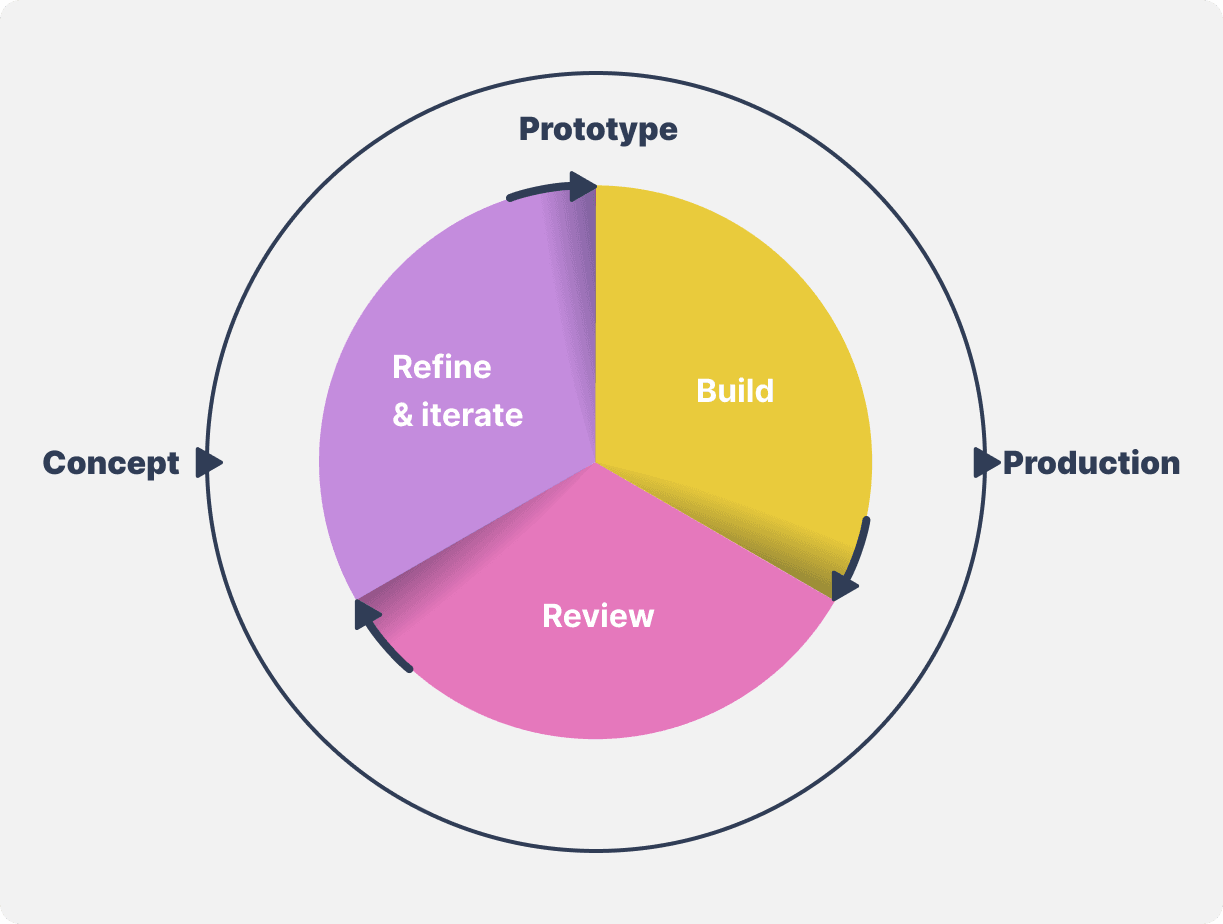
User Journeys
Knowing your user is one of the essential components of product development. It is vital and customizes the whole development process. Developing and using a user journey tool is critical if you want to know your people better and provide better services to them.
Additionally, it aids in creating a more robust, durable product that meets specific needs and demands and even foresees them. Considering how customer preferences and needs continuously change and evolve will directly affect how you develop your software solutions.
Artkai Expertise
Artkai is an award-winning full-cycle product development company. We organize the development process according to the Agile product development processes and methodologies to ensure that the client is always on track, receives timely updates from the team, and that the amount of time for expensive revisions and errors is minimal.
We make an effort to involve customers in the web and mobile app development process to create products that maximize your company's performance and are as closely in line with your company's values, objectives, and strategy as is practical. Let’s look at some of the successful case studies delivered by the Artkai team.
Internet Banking App for ProCredit Georgia
Our client, ProCredit Georgia, wanted the bank to go completely digital to relieve the burden on contact center staff, enable bank customers to sign up for and use new services online, and improve the usability and accessibility of current functions. The Artkai team has followed the best practices of Scrum methodology to optimize the product development process.
Our team redesigned the mobile banking app, built an online banking platform with a dashboard and quick access navigation, and added video identification features for onboarding, smart login, and the My Finances and bank account registration sections. Our efforts had an impressive effect:
- 99 percent of banking services became available online
- Money transfers through the mobile banking app and the web became two times faster.
- Blocking a card via a mobile banking app now happens 60 percent more quickly.
- Mobile app logs became twice faster in comparison to the previous version.
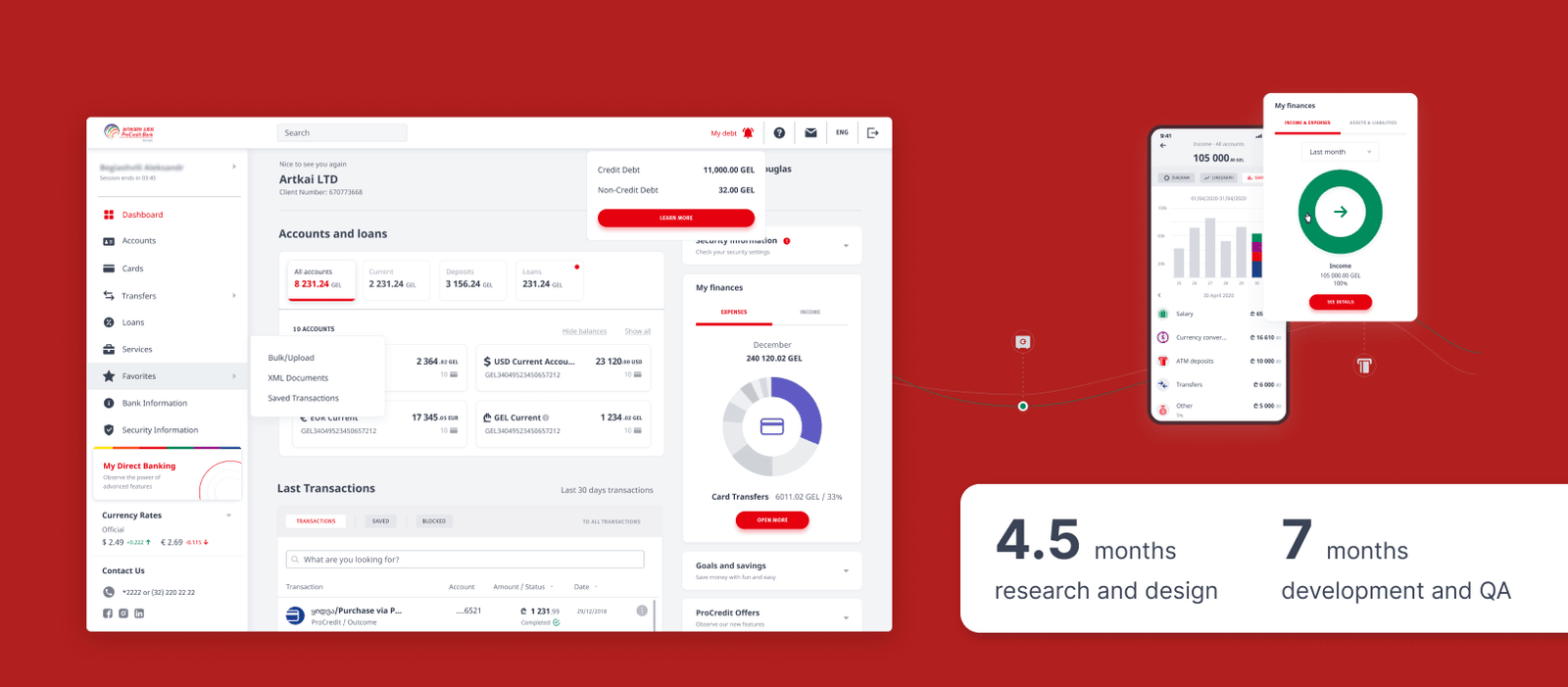
CoinLoan: A Web-based P2P Lending Platform and Marketing Website
In order to attract financial experts and enthusiasts, the first marketplace-based crypto-to-fiat lending platform, Coinloan, set out to develop a web-based P2P lending platform with a contemporary crypto-related design. Additionally, the customer wanted to create an attractive marketing website to promote the platform.
The Artkai team has followed the best practices of Agile development, designing and developing the product in parallel after the research and discovery phase. We improved the platform's usability and simplicity by building platform features on the knowledge gained throughout the research process. With the omnichannel experience in mind, Artkai created a customer journey map that considers marketing interactions, web, mobile, and physical branches.
As a result of Artkai's collaborative efforts, the client received:
- An engaging, practical, and informational website
- An easy and rewarding experience of using a comprehensive, secure, and straightforward platform.
- More than 100,000 active users on the platform.
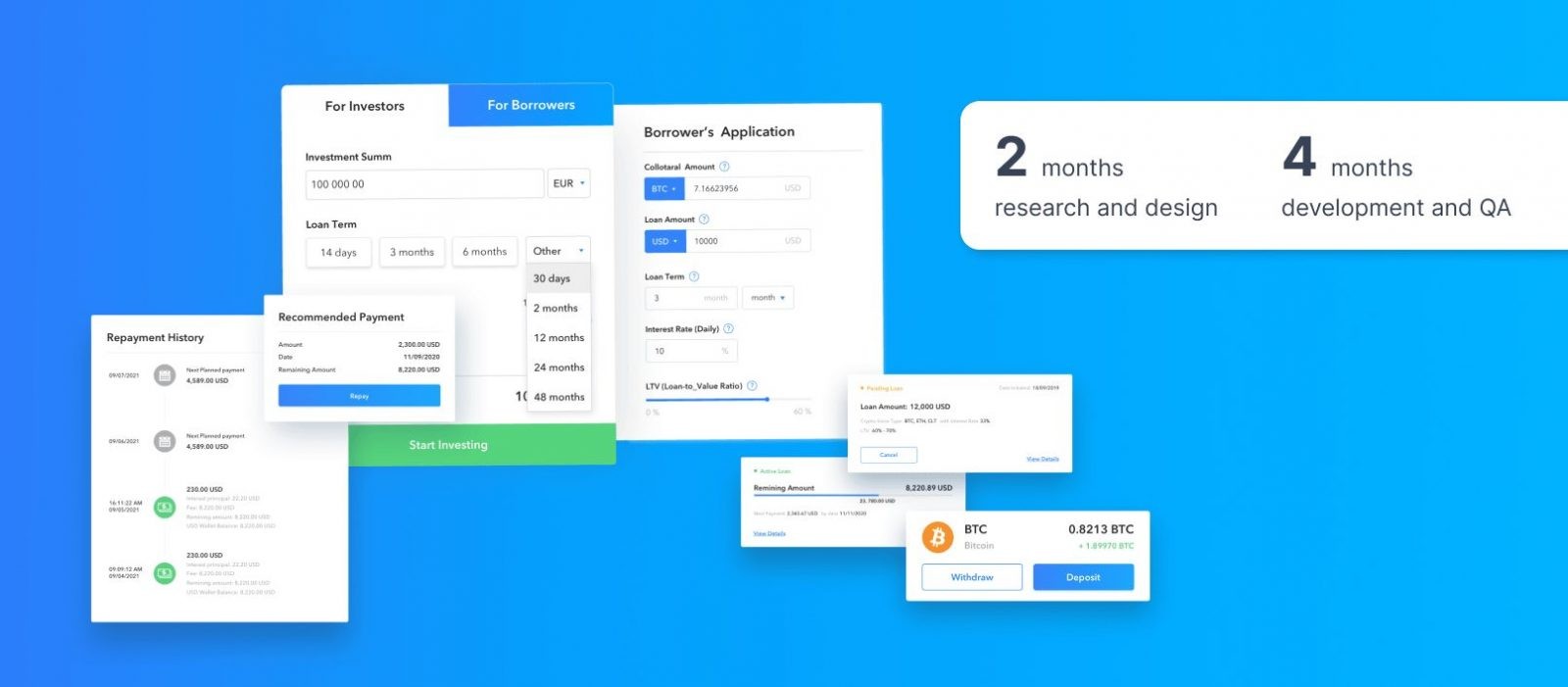
Cruitment: SaaS Platform for the HR and Recruitment Teams in SME
Our client, Cruitment, sought to develop a new corporate identity and a SaaS with separate user flows for recruiters and job seekers. To provide a single-board perspective of the recruiting progress, the Artkai team employed a Kanban board while developing a SaaS platform for SMEs' HR/recruitment teams.
The following are the results of the new recruitment platform and brand identity developed by the Artkai team:
- The number of applicants rose by three times.
- The number of accepted offers has doubled.
- Average cost per application dropped by 1.5 times.
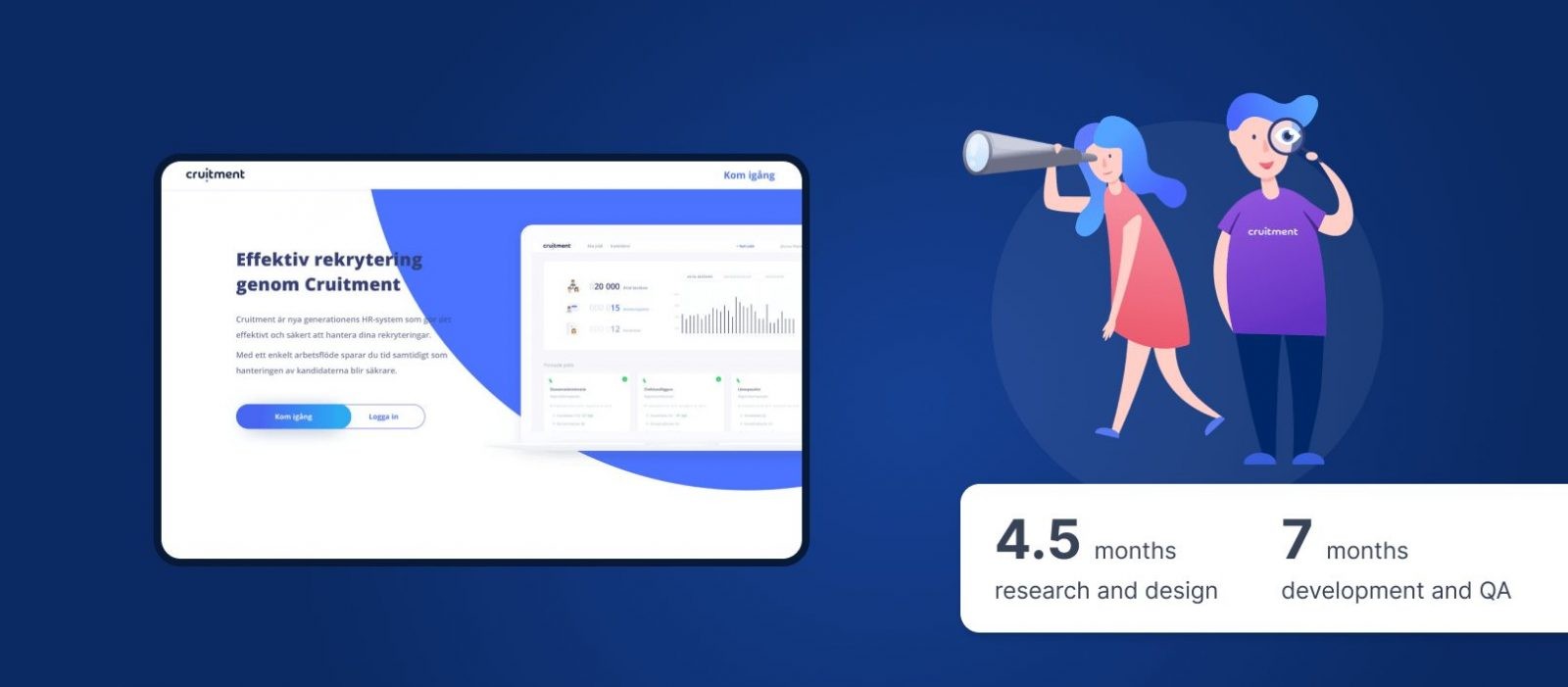
Huobi: Mobile Trading Platform
The world's largest blockchain business, Huobi Group, aimed to research the European industry and identify notable UX trends and customer pain concerns. The Artkai team was tasked with modifying the mobile application for a new European market and building a marketing website specifically for Europe.
We have used the best practices of Agile development to conduct face-to-face interviews with traders to learn more about how European audiences make decisions. After reviewing the data, our team generated a list of insights for the platform.
The Artkai specialists created a mobile platform and a marketing website for the European market to enable customers to conduct business operations anywhere and at any time. The client entered the European market due to our user-centered UX design, achieving the following outcomes when the project was finished:
- $1,2 trillion worth of transactions.
- 50 percent of all digital assets globally.
- 130 countries with millions of users.

Nezha: Blockchain Prediction Market Protocol
Nezha's mission was to develop a web-based blockchain prediction market system that would benefit investors, entrepreneurs, and gamblers. The idea was to allow participants to risk losing money on trades rather than putting their initial investment at risk. After the research and discovery phase, the Artkai team incorporated the best practices of Agile development to simultaneously carry out design and development.
The Artkai designers managed to gamify the platform. We found a middle ground between the manufacturing potential of the finance market and the gaming industry. We employed vivid neon highlights to create an instantly recognizable visual identity.
Several astounding outcomes have come from these discoveries:
- Product Discovery helped to clarify the project stakeholders' objectives and streamline the business process to retain clients by offering superior services.
- As a result, a challenging solution with simple navigation boosts platform usage and conversions.
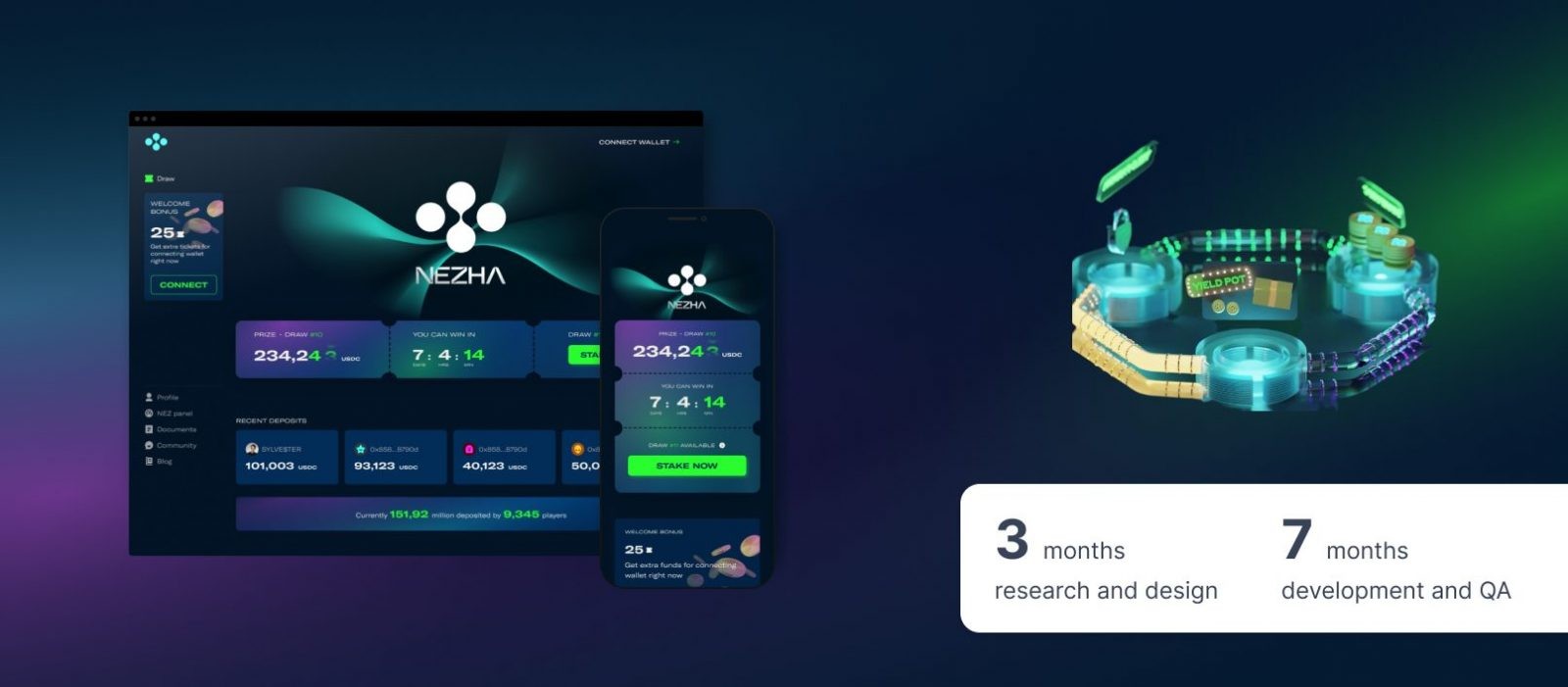
DTEK: Digital Transformation for Energy Sector Enterprise
DTEK, the power grid operator in Ukraine, aimed to simplify the processes for processing and paying electricity bills. Artkai assisted DTEK in implementing an agile, digitally informed, and design-focused solution. Customers of DTEK now have better access to comprehensive information, and DTEK aids them in taking charge of their energy usage to cut expenditures.
We created a solution architecture that converted a paper-based reporting system into an online system for monitoring consumption and making payments in compliance with the client's requirements. Here are the findings that DTEK obtained:
- An increase in the number of contracts for power consumption.
- There were three times fewer inquiries made to customer service.
- A 1.5-fold boost in consumer satisfaction.
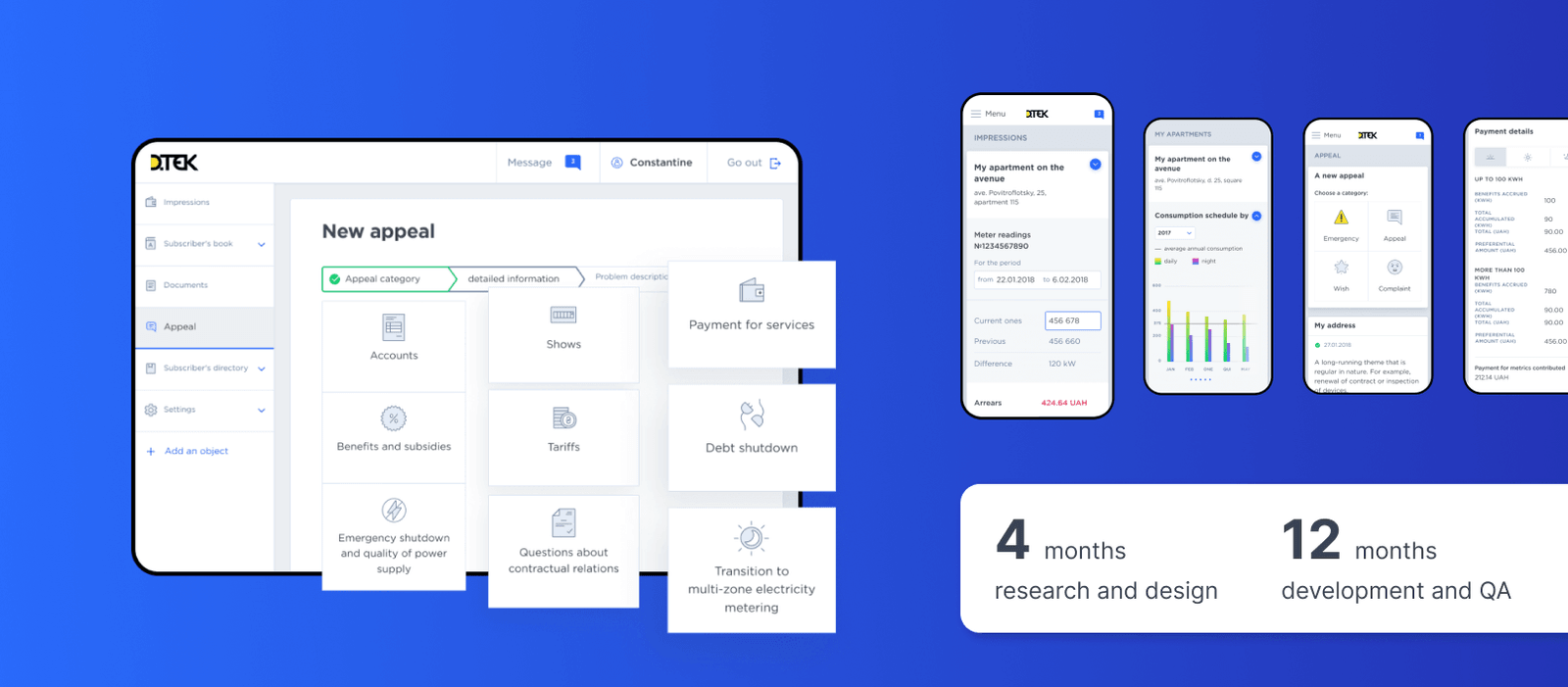
Boost Your Product Development Process with Artkai
A well-chosen product development methodology can significantly enhance the productivity of a cross-functional team. It helps to provide clear directions for carrying out a job, produce value quickly and effectively, and eventually drive the success of your product. Agile methodology provides a number of advantages over Waterfall or linear methods, allowing product teams to be more responsive to changes in user behavior and outperform market competitors.
At Artkai, we structure the development process in accordance with Agile product development methodology to make sure that the client is constantly on track, receives timely information from the team, and that the time for pricey modifications and errors is minimized. We also employ the best practices of Scrum and Kanban processes to encourage efficient problem-solving and support fruitful team cooperation.
Get in touch with an Artkai expert to consult deeper on product development methodologies.
Clients and Results
Schedule your free consultation
Don't miss this opportunity to explore the best path for your product. We are ready to delve into the specifics of your project, providing you with expert insights and optimal solutions.
Book your free sessionRead More
Explore articles from Artkai - we have lots of stories to tell
Join us to do the best work of your life
Together we advance the human experience through design.